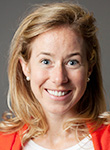Childhood obesity survey finds creative solutions
By H. Roger Segelken


Ask public officials, as Cornell social scientists did: What’s to be done about childhood obesity? Creative solutions, as it turns out, outnumber lame excuses.
“We heard relatively few buck-passing, shoulder shrugging, finger-pointing responses,” says researcher Rebecca S. Robbins, a Ph.D. candidate in the field of communication in the College of Agriculture and Life Sciences. “While some of these solutions were in the realm of the hypothetical, many suggestions revealed out-of-the-box thinking about the issue.”
“My favorite is a healthful alternative to classroom birthday binges,” adds Robbins, co-author of “Views of City, County and State Policymakers about Childhood Obesity in New York State,” published late last year in the online journal Preventing Chronic Disease: Public Health Research, Practice and Policy.
Leading up to the what-to-do question – for 48 elected and appointed officials within a two-hour drive of Ithaca – were three head-scratchers that could easily have prompted shoulder shrugs: Where does childhood obesity fall among other policymaker priorities? What do policymakers see as the causes of the rise in childhood obesity over time? And, whom do policymakers see as responsible for addressing childhood obesity?
Regarding priorities, the occasional mayor had other concerns, with one telling the researchers: “As far as my position as mayor, when I’m working with city issues [childhood obesity] is very low.” At the same time, other state legislators thought about childhood obesity as something that could set up lifelong struggles, worrying about “the potential for these children to become productive members of the workforce and help us solve these problems down the road.”
As for causes, parents were seen as bearing primary responsibility, officials told the researchers, but others pointed toward the offspring: “Kids are staying in and playing video games instead of going outside and playing,” one county executive said. “Instead of walking over to see a friend, [children] just text them.”
Many officials described the food industry, schools and the federal government as sharing responsibility for childhood obesity. At the same time, some were skeptical about broader involvement. For example, one state official got a little more specific, saying: “We’ve got physicians who are fat, so how can they tell somebody to lose weight, right?”
By then, the researchers (Jeff Niederdeppe, assistant professor of communication; Jamie Meyerson ’11, a development sociology student during the survey; and Helen Lundell, vice president of the Seattle-based Hartman Group) were ready for some good news.
“I’d love to see something in place for schools, like a club for the overweight, or free clinics where individuals are not forced to join,” suggested a county executive. A state lawmaker proposed legislation “in connection with whether or not soft drinks should be in vending machines in school districts.”
From one county official, they heard the healthful alternative to classroom birthday binges: “Rather than the parent bringing in cake and cupcakes and ice cream and all of that, on the day the child’s birthday is celebrated they get an extra recess to play … to promote that activity … rather than associating a celebration always with food.”
The Cornell researchers decided to conduct the study based on changes in physical, social, economic, information and policy environments during the past 30 years that have contributed to large increases in childhood obesity rates in the United States. “No single solution will be sufficient to offset these trends,” they concluded. “Large reductions in childhood obesity rates require action from multiple stakeholders, and public policy action is essential.”
Support for the study came from the Robert Wood Johnson Foundation.
Media Contact
Get Cornell news delivered right to your inbox.
Subscribe